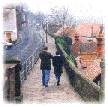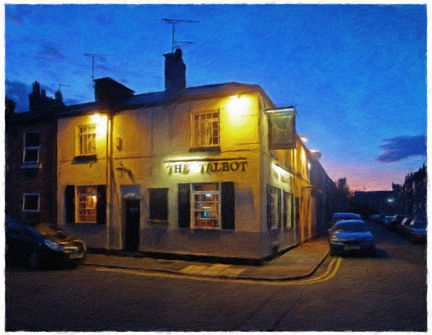  What's New? August 2019 What's New? August 2019
• The Talbot (locally known as 'The Dog') on the corner of Walter and Church Streets in Newtown, sadly closed on the 20th June 2019. Plans are currently in place for it to be converted into flats.
Here is a new page about it featuring some photographs by the author of the place just before it closed..
As with all of the lost pubs featured in these pages, your contributions, reminiscences and corrections are always welcome..
• The Flookersbrook on Hoole Road, formerly The Ermine, has been closed- again- for some time now. Rumours abound regarding its fate, and that of the large ex- car / furniture showroom next door but we will have to await events. The pub, despite appearances, actually has a long and interesting history. Visit its page here..
• An interesting new Facebook page from the great city down the road: The Lost Pubs of Liverpool
• The Watergate Inn, outside the Watergate and hard by Chester Racecourse was demolished to make way for a new entrance to the racecourse in February 2018.
The Chester Race Company bought the pub from pubco Enterprise Inns the previous year, with its final licencee Frank Marnell staying on for a while until his retirement after twenty five years.
Rumours of its fate soon abounded, which the race company’s head of marketing Stephanie Hughes attempted to scotch: “There are no immediate plans for it currently. We’ve invested in the aesthetics of the place to make it more presentable for race days and it is open for the season on race days".
Soon afterwards, plans were announced to radically re-model the entrance to the racecourse, strengthening rumours of the pub's impending demolition, which soon proved to be true. Below is the site today, fulfilling no particular purpose except to house a couple of canvas creations..
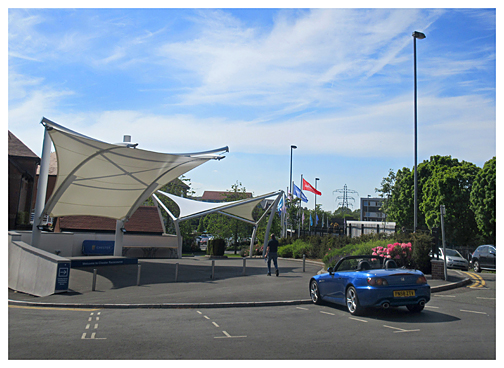 • Coming soon (we hope): The Living Pubs of Chester! We've written at length about our vanished hostelries of the past so we thought it was high time we also told the stories of the numerous places we are lucky enough to still have, most of them with long histories and fascinating tales to tell. • Coming soon (we hope): The Living Pubs of Chester! We've written at length about our vanished hostelries of the past so we thought it was high time we also told the stories of the numerous places we are lucky enough to still have, most of them with long histories and fascinating tales to tell.
It needs no saying that this will be a major undertaking so we appeal to you for help: your reminisciences, photographs and corrections are very welcome and credit for them will always be given.
This is also an expensive business: if your enjoy your visits to our sites, please consider donating a small sum to help us keep it online and growing for the benefit of all who love Chester and its historic pubs. Simply click on the PayPal form on our home page...
Restauranteurs and licencees: consider also publicising your business and helping our work by advertising to our thousands of worldwide visitors!
• The Home Guard Club at the bottom of Canal Street was demolished in July 2014 after falling into disrepair. Founded in 1945, the club's original home was in Lower Bridge Street, later moving to Roodee House and then Watergate House in 1964. It took over its purpose-built Canal Street premises in 1969 and remained there until the deteriorationg state of the building necessitated its sad closure. The cleared site of the old club is owned by the Canal and River Trust. They are utilising it as a car park until another use can be found for it.
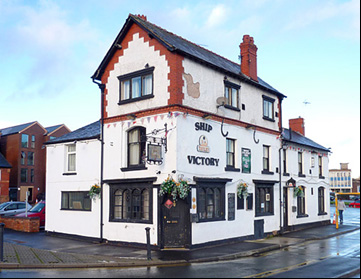 • The much-loved Ship Victory in Gorse Stacks, on the corner of George Street and what was William Street, closed, apparently for good, with the retirement of its longtime licencees Joe and Helen Gildea on New Year's Day 2014. • The much-loved Ship Victory in Gorse Stacks, on the corner of George Street and what was William Street, closed, apparently for good, with the retirement of its longtime licencees Joe and Helen Gildea on New Year's Day 2014.
The freehold of the pub is owned by Cheshire West and Chester Council, who are strongly suspected to have their grasping eyes on the site for demolition- we thought for student housing but now, it seems, to make way for an access to CWAC's new bus station on Gorse Stacks. Naturally, many local people consider the needless destruction of this excellent community pub to be an absolute scandal. More pictures and a short history of the inn are here.
By early Summer 2014, we had learned that The Friends of the Ship Victory had applied to purchase the pub and undertake all necessary repairs and upgrading, thus rendering CWAC's excuse that "it would take £150,000 to do this" obsolete. The Friends had also applied to the council to list the building as an ACV- an Asset of Community Value, which would allow them six months protection to buy the pub under the Localism Act 2011– but were shocked when the council refused their application, saying "it was not a viable asset”. It is thought it is the first time an ACV application has been refused by any local authority in the UK.
Council leader Mike Jones, who used to drink in the pub before football matches and has openly supported saving the Ship Victory, said: “I just love the old buildings in Chester, and for that reason I have insisted we have a full consultation. Unfortunately, the engineer cannot go forward with the bus interchange unless the Ship Victory is removed.”
A spokesperson for CWaC, one Rachel Ashley, said if the "preferred option" went ahead the Ship Victory would need to be demolished, but they would consider putting a plaque or information board to honour the pub. “It is a drive in, drive out facility, not one which would have buses reversing. The only straight forward way would be without The Ship Victory on site. Because it is in an area earmarked for redevelopment there is no community right to buy in these circumstances.”
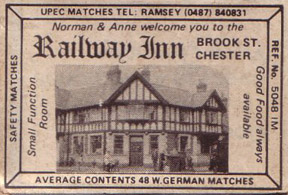 November 2015: Despite a spirited campaign to save the place, the Ship Victory was demolished a few days ago. November 2015: Despite a spirited campaign to save the place, the Ship Victory was demolished a few days ago.
• 29th May 2014: Here is an exceedingly grim, but true, tale concerning the long-lost Yacht Inn in Watergate Street.
• Another recent losss: The Railway Inn at the top of Brook Street. We had heard it was fated to be turned into a curry house- but it actually has just become a funeral director's- Funerals From The Heart. That's a first! The website contains some views of the interior as it is now that may be of interest to past habituees. Historic material about this house to follow. The licencee in 1919-20 was E Bennett.
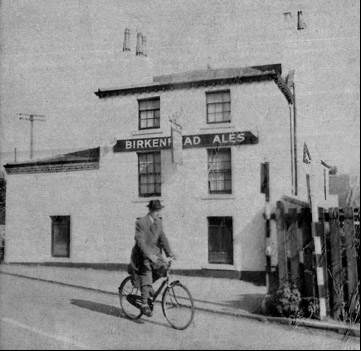 • We thought the suburbs and villages around Chester should get a look-in here too, so have added new categories covering Christleton and Ellesmere Port, Great Sutton etc. Your suggestions, memories and pictures of lost village pubs are very welcome! • We thought the suburbs and villages around Chester should get a look-in here too, so have added new categories covering Christleton and Ellesmere Port, Great Sutton etc. Your suggestions, memories and pictures of lost village pubs are very welcome!
• Here's a couple of questions for you. A friend recently gave us a bunch of interesting old photographs, among which was the image on the right, featuring a Birkenhead Ales pub. All of the other pictures were of the Chester area so we assume this one is too. Can anyone name it? We're led to believe it was in the Saltney area..
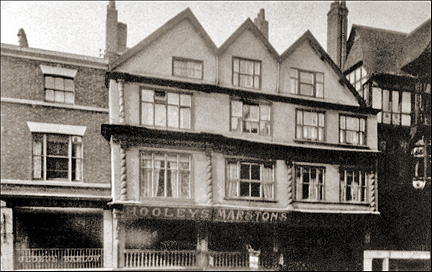 • On the left is a rather fuzzy old photograph of the 17th century 'Dutch Houses' in Bridge Street. The sign above the Row level says 'Hooleys Marstons' and therefore, I assume, a pub. I have no record of it and wondered if anyone else had. I have found licencees by the name of Hooley (Frederick) in Northgate Street and Handbridge (Elizabeth) but, so far, nobody trading here. Your suggestions are welcome! • On the left is a rather fuzzy old photograph of the 17th century 'Dutch Houses' in Bridge Street. The sign above the Row level says 'Hooleys Marstons' and therefore, I assume, a pub. I have no record of it and wondered if anyone else had. I have found licencees by the name of Hooley (Frederick) in Northgate Street and Handbridge (Elizabeth) but, so far, nobody trading here. Your suggestions are welcome!
• Another mystery: the press cutting on the right, describing the unhappy relationship of licencee Edward William Mere and his wife Anna, was taken from an 1897 edition of the long-vanished Chester Courant. We have at this time no idea where in Chester The Price Albert Inn (not to be confused with The Prince Alfred Inn in Egerton Street) was located and wondered if perhaps you did, dear readers?
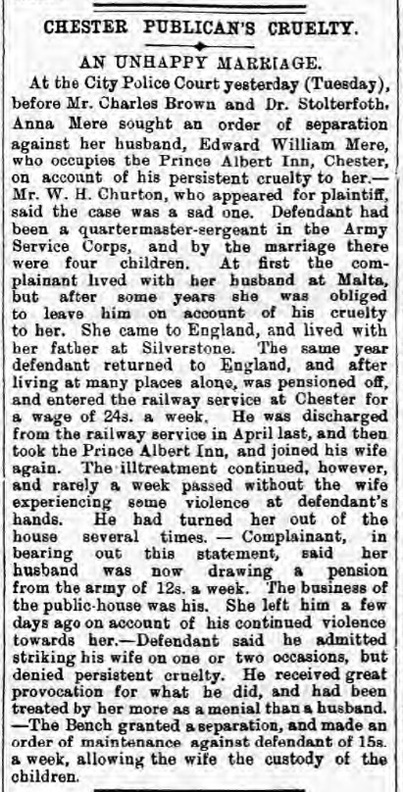 • It's a tad dated now but we still recommend a visit to The Chester Beer Project: "There are between 100 and 120 pubs in Chester. Our objective is quite simple- to drink in all of them, in one year, on Thursday nights. Who are we? We are a shadowy group who met many years ago through playing 5-a-side football on a Thursday night. Each game was always followed by a few pints. We're now too old to play, but we're not too old to drink. We like ale. Names have been changed to protect the innocent". • It's a tad dated now but we still recommend a visit to The Chester Beer Project: "There are between 100 and 120 pubs in Chester. Our objective is quite simple- to drink in all of them, in one year, on Thursday nights. Who are we? We are a shadowy group who met many years ago through playing 5-a-side football on a Thursday night. Each game was always followed by a few pints. We're now too old to play, but we're not too old to drink. We like ale. Names have been changed to protect the innocent".
The blog comprises brief, brilliant, savage reviews of the majority of Chester's pubs. Hilarious and spot-on, but undoubtedly not to everyone's taste, certainly not for the po-faced or the pubcos / licencees of many of the places mentioned, under whose tender care more than a few of which are likely doomed to join the ranks of the 'lost pubs of Chester'...
 We're very keen to acquire more anecdotes about the pubs, licencees and clientelle of the last few decades. Pictures too, if possible. These will, naturally, be treated with great care, scanned and returned. Full credit will always be given for contributions- or, if particularly scurrilous, anonymity is guaranteed! We're very keen to acquire more anecdotes about the pubs, licencees and clientelle of the last few decades. Pictures too, if possible. These will, naturally, be treated with great care, scanned and returned. Full credit will always be given for contributions- or, if particularly scurrilous, anonymity is guaranteed!
These pages, thanks largely to your valued contributions, dear readers, have rapidly grown to excessive length so we're planning a new layout as soon as time and money (a sore
point) allow. Talking of money... our Chester Virtual Stroll and its associated sites (such as this one) have, we hope, been
entertaining you for well over a decade now, but we really can't function
for much longer doing this for free. Please, please consider
helping us out in whatever way you can: donations are always gratefully
received, sponsorship of individual pages or chapters equally so. If
you have a pub, bar, restaurant or whatever, do yourself a favour and
put your advertising banner on the page or pages of your choice- support the living pubs of Chester!
"Beer was the driving force that led nomadic mankind into village life... It was this appetite for beer-making material that led to crop cultivation, permanent settlement and agriculture." Alan Eames
 he
production and consumption of strong drink has long been enjoyed in Chester. We know nothing concerning the drinking places of the Roman occupants of the
fortress of Deva Victrix, but much, perhaps, may be inferred from the Roman city of Pompeii, where there were said to be 900 bars (thermopolium)
and taverns (tabernae) to serve a population of a few thousand- in addition to the seamen, travellers
and traders of the port. Many of these establishments have been wonderfully preserved, down
to the drinking vessels (sometimes chained to the bar to deter theft) and grafitti scratched
upon their walls. he
production and consumption of strong drink has long been enjoyed in Chester. We know nothing concerning the drinking places of the Roman occupants of the
fortress of Deva Victrix, but much, perhaps, may be inferred from the Roman city of Pompeii, where there were said to be 900 bars (thermopolium)
and taverns (tabernae) to serve a population of a few thousand- in addition to the seamen, travellers
and traders of the port. Many of these establishments have been wonderfully preserved, down
to the drinking vessels (sometimes chained to the bar to deter theft) and grafitti scratched
upon their walls.
Granted, Pompeii was an affluent, settled civilian town at the heart of the empire whereas Deva was a frontier military fortress, but we do know that considerable
quantities of wine were brought here from the continent and that the
legions also became increasingly fond of a brew that had long been
produced on these islands, cervese (beer). Accounts dating from AD 90-130 found at the fort of Vindolanda on Hadrian's Wall show that considerable quantities of the stuff was purchased from local producers and one such, 'Atrectus the Brewer' (Atrectus Cervesarius) is the first named brewer in British history. And there seems little reason to doubt that others just like him
played their part in satisfying the thirsts of the thousands of soldiers, sailors, merchants
and others here in the great fortress of Deva.
"Before the Roman came to Rye or out to Chester strode, the rolling English drunkard made the rolling English road." G K Chesterton
Much about the drinking establishments of Saxon Chester are an equal mystery to us- as the 19th century
local historian Thomas Hughes wrote, "The Anglo-Saxons had their eala-hus (ale house), win-hus (wine house) and cumen-hus (inn) but there
are no records of their whereabouts". We do know, however, that a variety
of weak beer was the staple drink of the entire population, being much safer
than water, and the law stated that anyone brewing or selling bad ale would
have to pay a fine of four shillings, or be forced to "sit in a chair full of
dung" (certain modern brewers please note!) A chair mounted on the end of a long pole- the 'ducking stool'- was also utilised to repeatedly dunk bad brewers into filthy ponds.
“Whoever makes a poor beer is transferred to the dung-hill.” Edict in the City of Danzig, 11th Century
“The selling of bad beer is a crime against Christian love.” Law Record, the City of Augsburg, 13th Century
In the 14th century Chester mystery plays (see also a few photographs by the author here),
Christ redeems a bunch of characters from Hell- apart from the brewer
who heads straight for eternal damnation after admitting,
"Some time I was a tavener,
A gentle gossip and a tapster,
Of wine and ale a trusty brewer,
Which woe hath me bewrought.
Of cans I kept no true measure,
My cups I sold
at my pleasure,
Deceiving many a creature,
Tho' my ale were nought". |
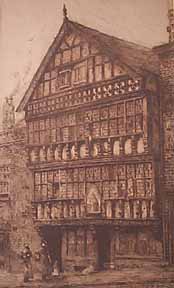 In 1552, during the reign of Edward VI, an Act was passed that restricted the number of taverns in London to 40 and in Chester just two. The guild system dominated and regulated the trade of old Chester. The Guild Mercatorial was divided into companies of two or three trades each and only members of these companies were permitted to trade freely. All others were deemed 'strangers'. 'The Company of Innkeepers, Victuallers and Cooks' was considered ancient when it was incorporated by Royal Charter under the Mayor of Chester in 1583. The restrictions of thirty years earlier upon tavern numbers had obviously been relaxed for 34 brethren were recorded at this time. The company enjoyed many rights and privileges including a monopoly on the sale of liquors within the boundaries of the city. In 1552, during the reign of Edward VI, an Act was passed that restricted the number of taverns in London to 40 and in Chester just two. The guild system dominated and regulated the trade of old Chester. The Guild Mercatorial was divided into companies of two or three trades each and only members of these companies were permitted to trade freely. All others were deemed 'strangers'. 'The Company of Innkeepers, Victuallers and Cooks' was considered ancient when it was incorporated by Royal Charter under the Mayor of Chester in 1583. The restrictions of thirty years earlier upon tavern numbers had obviously been relaxed for 34 brethren were recorded at this time. The company enjoyed many rights and privileges including a monopoly on the sale of liquors within the boundaries of the city.
In 1655, Lord Protector Oliver Cromwell divided England and Wales into eleven areas and placed each under the authority of a major-general. These officers were instructed "to encourage and promote godliness and virtue" and, in conjunction with the other justices of the peace, to put the existing laws against drunkenness into more effectual execution. Later the officers were ordered to see that "no house standing alone and out of a town was to sell ale, beer or wine, or to give entertainment."
The local regional officer was also very severe on horse-racing in Cheshire, where men have always liked horses, and he was equally severe on ale houses- his agents reported that in Cheshire they were "the places of receipt of wickedness, drunkenness, Sabbath breaking and other impieties"- and nearly 200 of them were suppressed in the city of Chester alone.
Breweries were prohibited from selling beer to any suppressed or unlicensed ale house keeper. A desire for moral reform doubtlessly lay behind these actions but there was an additional reason for them- ale houses, and especially those standing alone and out of a town were considered to be possible places of association for Royalists and as such dangerous to a minority Government which verged very closely on dictatorship.
"Alcohol sloweth age, it strengtheneth youth, it helpeth digestion, it abandoneth melancholie, it relisheth the heart, it lighteneth the mind, it quickeneth the spirits, it keepeth and preserveth the head from whirling, the eyes from dazzling, the tongue from lisping, the mouth from snaffling, the teeth from chattering, and the throat from rattling; it keepeth the stomach from wambling, the heart from swelling, the hands from shivering, the sinews from shrinking, the veins from crumbling, the bones from aching, and the marrow from soaking." Anonymous, 13th century
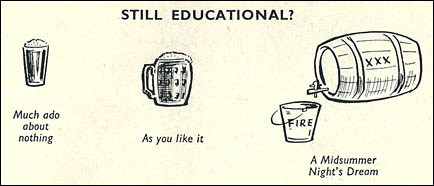 The Chester Directory for the year 1792 recorded
around 140 inns in the small market town. By 1858, numbers had increased considerably and Thomas Hughes recorded 36 trading
in Northgate Street alone, and several considered
by him ancient then continue to flourish today. The Chester Directory for the year 1792 recorded
around 140 inns in the small market town. By 1858, numbers had increased considerably and Thomas Hughes recorded 36 trading
in Northgate Street alone, and several considered
by him ancient then continue to flourish today.
There is an old and oft-repeated local saying that Victorian Chester boasted "a pub for every day of the year"...
Left: ain't it the case? From a 1963 copy of the Chester College rag mag.
Nontheless, times- and the brewing industry- have changed and well-loved pubs
continue to disappear or are 'improved' out of all recognition- often including
an unnecessary change of name. In some cases the buildings are retained and
adopted to other uses: the boarded-up Wheatsheaf Inn on Christleton Road
re-opened as Wheatsheafe Antiques and the historic Bear & Billet Inn (above) in Lower Bridge Street in 1999 was briefly converted into a pizza restaurant of all things, complete with an absurd new name, Benson's at the Billet. (It has, however, thankfully now returned to its ancient role as a traditional pub. You can see a 19th century painting of it by Louise Rayner here.) In 2002, the 18th century Ye Old Vaults in Bridge Street, affectionately known as Barlow's (see below) became a clothes shop with holiday apartments above. We will meet with numerous other examples in the following pages.
Over 500 Chester pub names have been recorded over the centuries. The locations of such evocative hostelries as The Bleeding Horse, The Hat & Beaver, and The Blackamore's Head are sadly lost to us (these and others, until we manage to track them down, are listed under unknown locations). Here, however,
we will attempt to tell you what we do know about the huge number of Chester's public houses that are no longer with us. Your additions, reminisciences, pictures (scanned and returned promptly) or corrections are always most welcome, as is your financial support for the project- advertising your pub here does us both a lot of good (and, of course, helps keep it out of our lists!) and your donations, no matter how small, really do make a great difference. Cheers!
"What two ideas are more inseparable than beer and Britannia?" Rev Sydney Smith, English clergyman and writer.

The Vanished Pubs of Chester
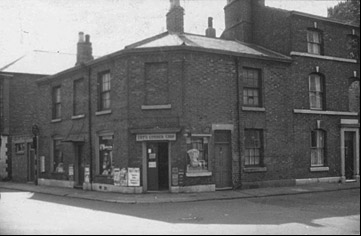 Barker's Lane: (an early name for Union Street). There was a pub on Barker's Lane called The King's Arms, and this is the same name as the King's Arms on Union Steet run by the Bennion family. In 1828 it changed it's name to The Union Arms before reverting back to The King's Arms in 1850. This Union Arms is mentioned in Pigot's Directories for 1818-20 and 1828/9 when the licencee was James Fitzgerald in both cases. Barker's Lane: (an early name for Union Street). There was a pub on Barker's Lane called The King's Arms, and this is the same name as the King's Arms on Union Steet run by the Bennion family. In 1828 it changed it's name to The Union Arms before reverting back to The King's Arms in 1850. This Union Arms is mentioned in Pigot's Directories for 1818-20 and 1828/9 when the licencee was James Fitzgerald in both cases.
In June 2012, Beryl Dix in faraway Tasmania wrote to tell us that, in 1881, her ancestor Barker Jones was the victualler at the famous King's Arms Kitchen in Eastgate Street. It is interesting to see his christian name used in a street where there was an inn with the same name as his. Was there a connection?
Bars (The): Listed under T
Black Diamond Street: The Ostrich Vaults stood on the corner of Black Diamond Street and St. Anne's Street.
The 1871 trade directory lists it as The Ostrich and it is shown as an unnamed public house on a 1911 map. After it closed around 1912, it became a shop and is illustrated as such on the right. The building on the extreme left of the photograph still stands, was once a branch of the Co-op and is now a toll retail and hire business, Machine Mart. The former George Hotel (see below) is just beyond that. The Ostrich's site is now a car park. It has its own page in our lost pubs gallery..
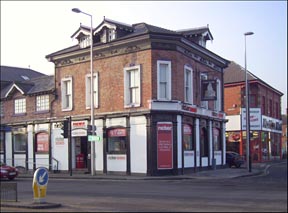 The George Hotel (no. 5, now the corner of the busy Hoole Way stretch of the Inner Ringroad, illustrated left in February 2010). The George was, after sitting empty for a considerable period, converted for residential and commercial use and, replete with a brand new sign saying 'The Old George', houses a pizza company and, until recently, a TV and hi-fi retailer (now moved to the poor old Beehive further along Hoole Road) with flats above. At the time of this latest update, June 2014, the shop premises remain empty.. The George Hotel (no. 5, now the corner of the busy Hoole Way stretch of the Inner Ringroad, illustrated left in February 2010). The George was, after sitting empty for a considerable period, converted for residential and commercial use and, replete with a brand new sign saying 'The Old George', houses a pizza company and, until recently, a TV and hi-fi retailer (now moved to the poor old Beehive further along Hoole Road) with flats above. At the time of this latest update, June 2014, the shop premises remain empty..
An advertisement in a 1903 guide book mentions a most interesting room at the George: “The GEORGE HOTEL Black Diamond St., is well worth a visit, on account of its Grand Room of UNIQUE OIL PAINTINGS of CHESTER in the olden times.”
One wonders what became of them. The landlord at this time was Richard Billington, who was still there in 1910. Earlier, in 1857 it was William Axon, in 1880 Henry Hewitt, in 1881 William Howard Roberts, in 1914 F W Attewell, in 1919-20 E J Webster, in 1934 David Thomas and in 1936-42 William Hughes. You can see a larger photograph of the George in our gallery.
Blacon: On 10th July 2003 time was called on The Lord Byron in Shelley Road. This 1960s local was demolished and replaced with a
41-bedroom old people's home. A campaign and petition against closure
by regulars, who considered the Byron a "vital community
resource and popular meeting place", was ignored by councillors and
planners who, to quote the local press, "felt that the loss of the pub
could be accomodated by other facilities in the area, such as the
Highfield pub". In addition, they said, the proposed residential home "is considered to likely to improve the streetscape".
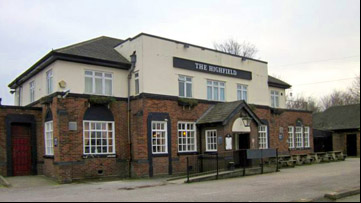 Ironically, The Highfield, on Saughall Road (illustrated right), itself closed a decade later, in February 2014. Nearly a year later, in January 2015, it was announced that owner Empire Inns had sold the pub to Sanctuary Housing, whose intention was to demolish it and erect in its place affordable housing units for the over 55s. Ironically, The Highfield, on Saughall Road (illustrated right), itself closed a decade later, in February 2014. Nearly a year later, in January 2015, it was announced that owner Empire Inns had sold the pub to Sanctuary Housing, whose intention was to demolish it and erect in its place affordable housing units for the over 55s.
A spokesman for Sanctuary said it had yet to submit a planning application and was now in the process of "consulting with the local community". Watch this space. The Waggon & Horses on Western Avenue is now Blacon's sole surviving pub. The Highfield was demolished in early April 2017.
"Wine is but single broth, ale is meat, drink, and cloth." 16th century English proverb.
Boughton (see also Christleton Road): The Red Lion. No. 30, corner
of Beaconsfield Street. Landlord in 1822-3 T Edwards, in 1934 G J Challoner, in 1936-42 John Holmes. The site is now occupied by a bank.
Occasionally, we make mention of pubs that are still with us but whose names have changed. Thus, the recently-refurbished and re-opened Little Oak, close to the corner of Hoole Lane, was, in 1871, known as The Royal Oak.
We found The Oddfellow's Arms on a Chester map of 1871, located at 3 Boughton. Henry Rathbone was the licencee from 1860 to 1865. He had been at the Bird in Hand (see below) in Boughton in 1857.
The inn stood at the junction of the Tarvin and Christleton roads, close to St. Giles's Graveyard, once the site of the ancient Boughton Chapel which was demolished as a defensive measure during the early stages of the Siege of Chester in the Civil War. Along with neighbouring properties, it was demolished to make way for an ornate 'Chester black-and-white' building of 1900 by the prolific Chester architect John Douglas, which is still with us today, albeit serving in the menial role of a garage door showroom. You can see a picture of it in our History of Boughton feature. For the moment, we know nothing else about the old inn however..
 The Bird in Hand Beerhouse appeared in the Chester Trades Directory for 1840 when the proprietor was Thomas Gillins. In 1857 it was Henry Rathbone, who went on the the Oddfellow's Arms (see above). Another Bird in Hand continues to thrive in the neighbouring village of Guilden Sutton. The Bird in Hand Beerhouse appeared in the Chester Trades Directory for 1840 when the proprietor was Thomas Gillins. In 1857 it was Henry Rathbone, who went on the the Oddfellow's Arms (see above). Another Bird in Hand continues to thrive in the neighbouring village of Guilden Sutton.
The Coach & Horses. Listed in the Chester Trades Directory in 1840 when Josias Bailey was the licencee, in 1850, licencee was John Smith, in 1855 William Musgrave and in the 1857 Post Office Directory of Cheshire, T Smith. The inn is no longer listed in the 1871 directory.
The Engine House Tavern, Richmond Place (also listed as 111 Boughton). The first we have learned about this inn is that it was originally called The Richmond Place Beerhouse and is listed as such in the 1871 census. It was more popularly known as Ruscoe's, after the family who took it on in 1807. It became The Engine House Tavern in 1880 and remained as such until it closed as a pub. Elizabeth Ruscoe, the licencee, also ran a cab hire business (horse-drawn back then) from the back of the pub, where there was a large yard and outbuildings. The licence was taken over by Thomas Reece in 1890. Mr Reece was a former policeman who had served in the force for 20 years. In 1919-20 Mrs H Butler held the licence and in 1936 Mrs Emily Shepherd.
After closing, the old inn
became a restaurant by the name of Locus. It currently (2011) houses an Indian restaurant called Shillong.
Many thanks to Gloria Rathbone, a descendent of the Ruscoes, for much of the above information.
You can see a photograph of The Engine House in our gallery.
The handy-sounding Phoenix Tavern and Shop traded in Boughton in 1840, licencee John Hughes.
Pigot's Directory for the years 1818-20 lists the nautical-sounding Anchor & Dolphin trading somewhere in Boughton, licencee R Tummins. (still there in 1823).
The White Horse. Licencee in 1822-3 Ralph Rogerson, in 1828 Mrs Wright, in 1902 Frederick Bulger.
The Barley Mow. The Cheshire Observer, 1st February 1868, reported that the licencee (name unknown) of the Barley Mow, Great Boughton, had been summoned for selling beer out of licenced hours.
The Grapes public house was mentioned in a Police Court case reported in the Cheshire Observer , 24th August 1895.
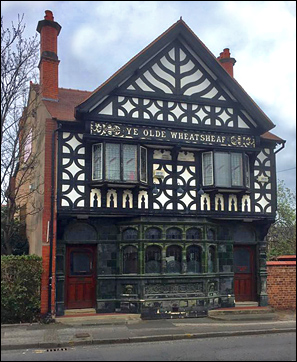 'The Grapes' is a very common pub name in Liverpool but we've only traced two trading in Chester so far- one here in Boughton and one in Bridge Street (see below). 'The Grapes' is a very common pub name in Liverpool but we've only traced two trading in Chester so far- one here in Boughton and one in Bridge Street (see below).
After closing as a pub (when was this readers?) Ye Olde Wheatsheaf on Christleton Road
(right) re-opened as 'Wheatsheafe Antiques'.
J Davies was its licencee in 1822-3 and James Powell, when it was The Wheatsheaf Tavern, in 1840. In 1855 it was Thomas Tapley. It appears as The Wheatsheaf Inn on our 1871 Chester map but is absent from the directory for that year.
Every year at Harvest Festival time the vicar of nearby St Paul's Church would hold a service in the bar, surrounded by fruit and vegetables collected by the locals, which was donated to charity afterwards.
The Plume of Feathers. This inn was listed in Cowdroy's Directory in 1789, when the licencee was Ann Challiner, in Pigot's Directory 1818-20, licencee C Challinor and in Pigot's Directory in 1828 when the licencee was Sarah Challinor. (at least forty-odd years of Challinors) Another Plume of Feathers was trading in Bridge Street at this time.
The Ship & Plough was listed in Cowdroy's Directory in 1789 when the licencee was Stanley Burrows. He was there also in an earlier directory, in 1781. The Ship Inn (the same place with a name change?) appears in Pigot's Directory for 1828/9 when the licencee was Jas. Davies. He and his pub are also listed in 1822-3. There were other Ships in Bridge Street and at Crane Wharf. The Ship Tavern was mentioned in a 1749 Chester Courant, when the landlord was a Mr Matthews, and in Pigot's 1818-20 Directory, licencee John Leake.
The King's Head is listed in Pigot's Directory for 1818-20 when the licencee was John Ellis, in 1822-3 M Davison, and in 1828/9 Catherine Ellis. The Old King's Head continues to thrive in Lower Bridge Street.
The Farriers' Arms is also listed in Pigot's Directory 1828/9 when the licencee was Mr Wright.
The Foresters' Arms (no 10 Boughton, east side, close to the corner, of Sandy Lane) was listed in the Chester Trades Directory for 1850 when the licencee was John Gerrard. On the site now is a cafe and deli by the name of Fude.
Readers may be interested to learn that, in 1871, across the road from the Foresters' and right next door to the still-thriving Gardener's Arms, was located a female penitentiary.
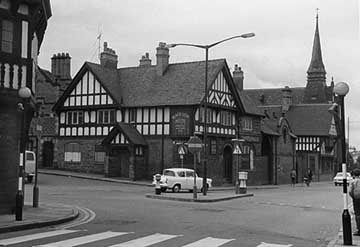 The Black Lion Inn-
no. 166 Boughton, corner of The Mount- illustrated right. Now a landscaped, but otherwise empty, space. It was supposedly
demolished for road widening but also, allegedly, because of the
'undesirable' nature of some of the regulars, or so we were informed-
by one of them! The Black Lion Inn-
no. 166 Boughton, corner of The Mount- illustrated right. Now a landscaped, but otherwise empty, space. It was supposedly
demolished for road widening but also, allegedly, because of the
'undesirable' nature of some of the regulars, or so we were informed-
by one of them!
This inn was listed in Cowdroy's Directory in 1789 when the licencee was Thomas Blades and Pigot's Directories for the years 1818-20 and 1828 show William Twemlow in charge. The landlord in 1840 was John Twemlow. His entry in the 1840 trades directory lists him as 'Silversmith and Black Lion Inn'. He was still there in 1857. In 1871 the licencee was Mary Chesworth, 1880 David Jackson, in 1902 John R Tushingham, who was still there in 1936, in 1942 was John H Tushingham. (40 years between them- What was their relationship?)
Reader Paul Adamson told us, "The Black Lion closed in the early seventies. The final licensee, Gordon- I don’t remember his surname (but see below)- was a nice friendly young bloke who ran a good pub. He was a keen scuba diver when not pulling pints but tragically drowned in an accident whilst diving off the Wirral either just as the pub was closing or very shortly after. I can still recall in vivid detail a large charcoal caricature he had posed for smiling down from its perch above the optics. As your other correspondent mentioned, there was a rumour, rife at the time, that the place closed on account of its undesirable patrons. I don’t to this day know the real reason they knocked this handsome building down but an old regular said to me one night in there just before the axe fell, “You mark my words son-they’ll knock this place down and do nowt with it”.
In June 2009, we received the following letter: "The last manager of the Black Lion was Gordon Dentith who died on 3rd June 1972 whilst on a short holiday in Anglesey. I should say I am his eldest daughter Anita. He died two years after the pub was pulled down on the pretext that the road was to be altered. He left three young daughters and a wife who has also recently passed away. Regards, Anita Watson (nee Dentith)."
More photographs of Black Lion can be seen in our gallery. The excellent Mount Inn, with its unrivalled views over the River Dee and Meadows, continues to thrive just around the corner. We wonder when The Mount was established as a pub as it does not appear as such on our 1871 Chester map, but as a private house. A small list of vanished Chester pubs displayed on the Mount's wall is what got me started on this interminable quest in the first place!
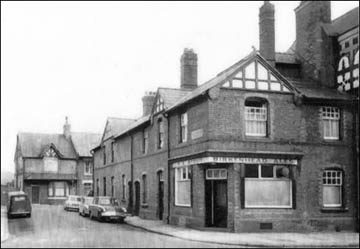 Pigot's Directory in 1818-20 and 1828, The Chester Trades Directory in 1850, Slater's Directory 1855, The Post Office Directory 1857 and Slater's 1880 all list an inn called The Mount Pleasant Tavern trading in Boughton, its licencee in 1818-23 being M Ramsey, in 1828 William Mayler, in 1840 Joseph Lloyd, in 1850-57 Mrs Catherine Lloyd, in 1871 James Law and in 1880 Edward Lewis. Pigot's Directory in 1818-20 and 1828, The Chester Trades Directory in 1850, Slater's Directory 1855, The Post Office Directory 1857 and Slater's 1880 all list an inn called The Mount Pleasant Tavern trading in Boughton, its licencee in 1818-23 being M Ramsey, in 1828 William Mayler, in 1840 Joseph Lloyd, in 1850-57 Mrs Catherine Lloyd, in 1871 James Law and in 1880 Edward Lewis.
The Harp Vaults (no. 58 Boughton and 34-36 Beaconsfield Street: illustrated right), was dirctly across the road from the Universal and Waterloo Inns. Its site is also now a grassed-over empty space. Its landlord in 1919-42 was Ernest Brazendale. More photographs of it are in the gallery.
The Volunteer is mentioned in Pigot's Directory for 1828/9 when the licencee was George Rhoden.
The Universal Inn (no. 71, corner of Victor Street) and The Cheshire Sheaf (no.79, corner of Fosbrook Street, both illustrated left) were demolished and a petrol station erected on their sites this in turn was demolished, leaving a vacant site for some years until the neighbouring Boughton Retail Park was acquired by Waitrose in 2009. This they duly flattened and erected their vast and shiny new store in its place. A gallery of images of the changing face of the area is here.
The Sheaf's licencee in 1919-20 was E Slavin, in 1934 Mrs M Slavin, in 1936 Thomas Johnson, also in 1936 Charles Crowe, from 1937 to 1961, David & Phyills Slyfield. The Universal's, in 1919-20 was O Lennon, in 1934 H Wilkes. Larger photographs of the Sheaf and the Universal may be seen in our gallery.
“It is a pleasure to souls to become moist. A man, when he gets drunk, is led by a beardless lad, tripping, knowing not where he steps, having his soul moist. It is death to souls to become water”.
Nietzsche
In August 2014, we received the following fascinating letter regarding the Cheshire Sheaf from reader Gloria Rathbone:
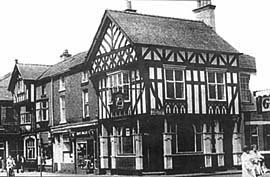 "Charles Cordery was the owner of the pub in Boughton called The Cheshire Sheaf. Initially it was a house and shop, where Charles was a baker and supplier of ‘provisions'. It also became a beerhouse, licensed to sell beer and wine only. Each year Charles applied for a license to sell spirits also, but each year for 18 years he was refused! After he died in 1881 his son, also called Charles Cordery, took over the pub and also applied to sell spirits and he too was refused, despite extending and making changes to the pub interior. "Charles Cordery was the owner of the pub in Boughton called The Cheshire Sheaf. Initially it was a house and shop, where Charles was a baker and supplier of ‘provisions'. It also became a beerhouse, licensed to sell beer and wine only. Each year Charles applied for a license to sell spirits also, but each year for 18 years he was refused! After he died in 1881 his son, also called Charles Cordery, took over the pub and also applied to sell spirits and he too was refused, despite extending and making changes to the pub interior.
In June 1894 he bought the Old Nags Head in Foregate Street and had a manager run the Cheshire Sheaf. Following a dispute between Charles and the manager, Charles sold the Cheshire Sheaf and just kept the Old Nags Head. Charles Jnr was secretary of the Licensed Victuallers' Association. In the early 1900s Charles moved to Bunbury to a pub called The Swan Inn, where he remained until he died, leaving Chester behind.
Charles Cordery junior was married to Sarah Jane Ruscoe, whose parents had the pub in Richmond Place latterly called The Engine House Tavern.
Henry Cordery, son of Charles snr and brother to Charles jnr, was also involved in the trade as he was landlord of the Masonic Arms in Northgate Street from 1890 to 1895. In 1894 Henry was granted a license for two booths on the Roodee for the duration of Chester Races. In 1895 he moved to the (still thriving) Pied Bull, also in Northgate Street. I have discovered this information on the Corderys as I was researching the Ruscoes, who are my ancestors".
Unlike today, Boughton and Foregate Street formed part of the same stretch of road and the boundary between them was far from clear, as consequently was the address of some of the area's inns. The Exchange Vaults, for example, which was at 165 Foregate Street, the very last house on its north side, somewhere around where Bar 69 is, mid way in between City Road and Russell Street- considered part of Boughton today.
The landlord in 1871 (and probably earlier) to his death in 1874 was John Dodd. It appears in the 1878 Post Office Directory, when the licencee was Henry Lunt, who was still there in 1880 (Slater's Directory of N and S Wales etc). The place had the address 147 Foregate Street at this time. By 1883 its street number had changed to 165 and Emma Lunt was in charge (Slater's Directory of Cheshire and Liverpool). John West was landlord in 1893-1894 (Chester Directory) and still in charge in 1896 (Kelly's Directory of Cheshire). In 1902, Elizabeth West had taken over and the street number had changed yet again, to 169 (Kelly's Directory of Cheshire) and in 1910-14 Matthew Frow was there.
The Waterloo Vaults (no. 67) - now the Chester Backpacker's Hotel. Licencee in 1818-40 (when it was called The Waterloo Tavern) was Richard Chadwick, in 1850 Thomas Chadwick, in 1855-9 James Nuttall, in 1871 Thomas B Potter, in 1880 (when it was listed simply as The Waterloo) William Stewart, in 1902-1910 Mrs Elizabeth Addis, in 1914 Thomas Addis, in 1919-20 James Waldron, in 1935-6 Frederick H Frow. The pub was listed as The Waterloo Inn in his time.
Some photographs of it are in the gallery.
The Tub stood roughly opposite The Waterloo Vaults at 38 Boughton and was mentioned in the Chester Trades Directory in 1850 when the licencee was Sarah Yates. In 1857-58, the landlord was Michael Collins (Post Office Directory of Cheshire), but by 1861 there is mention in the Chester Chronicle of a Michael Collins running a pub in Boughton called The Barrel & Grapes, perhaps suggesting that he had changed the name. Our 1871 Boughton map shows a pub simply called The Barrel located six properties west of Steven Street.
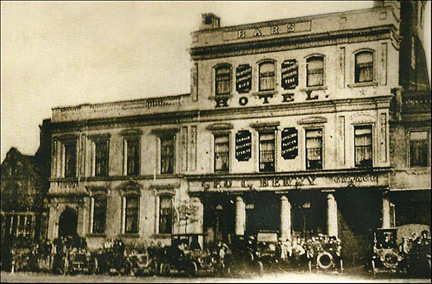 It's interesting to note that, according to the Chester Observer in 1869-71, there is a Michael Collins residing in Steven Street in Boughton who owned a pub called the Erin go Braugh. The area around Steven Street was a very densely populated and poverty-stricken Irish district during that time, so it's hardly surprising that the pub's name was roughly translated as 'Ireland Forever'. It appears on our 1871 Boughton map, standing roughly opposite to the still-thriving Cross Foxes Inn. It's interesting to note that, according to the Chester Observer in 1869-71, there is a Michael Collins residing in Steven Street in Boughton who owned a pub called the Erin go Braugh. The area around Steven Street was a very densely populated and poverty-stricken Irish district during that time, so it's hardly surprising that the pub's name was roughly translated as 'Ireland Forever'. It appears on our 1871 Boughton map, standing roughly opposite to the still-thriving Cross Foxes Inn.
The Bars Hotel (illustrated right in 1910). When this closed in the early 1970s it became The Tavern in the Town with King's Nightclub above. It was later transformed into Cindarella Rockafella's nightclub.
With it's 'monk's retreat' and impressive facade- which could easily
have been preserved- it was nontheless demolished to make way for a large 'luxury' apartment
development. JD wrote to tell us, "One of the pubs I can vaguely
remember a few years ago was The Schooner Inn which was next door to Cinderella Rockerfellas. If I remember correctly it changed to The Sports Bar which was at its busiest on a Sunday night".
Reader Hoolite also recalled, "Oh, yes, I remember Sports Bar alright. Lots of neon and chrome in the 'Amercian' tradition, a couple
of pool tables, long bar on the right hand side as you walked in.
Guaranteed major ruckus on most nights, being positioned right next
door to Cinders, which was the first club I ever went into being about 16- they weren't too choosy".
More information under The Bars and you can see a photograph of the hotel in 1910 and Cinder's just before it was demolished in the gallery.
The Ram Inn. Advertisement in Adams’s Weekly Courant, 11th April 1780: "RAM INN; Great Boughton. JOHN RICHARDSON, Cabinet-maker, from Tarporley, impress’d with a Sense of Gratitude for the many Favours he has already received, takes this Opportunity to thank his Friends and the Public in general, for all their past Favours conferr’d upon him; and hopes, by his diligent Attention and Study to please, all who have formerly made the old Ram their House, will still confer their Favours on their most respectful, and most obedient, humble Servant, JOHN RICHARDSON".
Joseph Loyd had the place in 1818-20, Thomas Venables in 1822, Charles Weaver was the landlord in 1828 and Thomas Tapley in 1840.
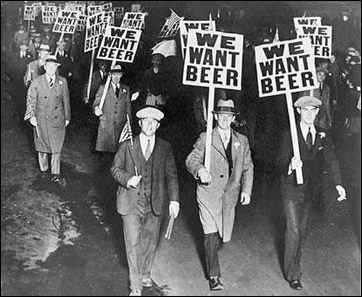 The Chester Trades Directory for the year 1850 mentions a pub in Boughton with the cheerful name of The Jolly Gardener Tavern at 33 Christleton Road, landlord Joseph Horrocks, who had been there in 1840. It was still called this in 1855 when Charles Chesworth was in charge. He was still there two years later in 1857 but the inn's name had changed to The Gardener's Arms. Earlier, in August 1828, the Chester Chronicle mentioned an inn "opposite Sandy-lane, Boughton" called The King's Head- exactly in the location where The Jolly Gardener / Gardener's Arms would later be. So we can safely assume this was the same inn under three different names. The Chester Trades Directory for the year 1850 mentions a pub in Boughton with the cheerful name of The Jolly Gardener Tavern at 33 Christleton Road, landlord Joseph Horrocks, who had been there in 1840. It was still called this in 1855 when Charles Chesworth was in charge. He was still there two years later in 1857 but the inn's name had changed to The Gardener's Arms. Earlier, in August 1828, the Chester Chronicle mentioned an inn "opposite Sandy-lane, Boughton" called The King's Head- exactly in the location where The Jolly Gardener / Gardener's Arms would later be. So we can safely assume this was the same inn under three different names.
The Bull's Head. This inn was listed in Cowdroy's Directory in 1789 when the licencee was Richard Coddington.
The Red Lion was also listed in Cowdroy's Directory in 1789, its licencee being William Edwards. After his name is the additional entry, "Cooper". Pigot's Directory shows Thomas Edwards as licencee in 1818-20.
The Royal Oak was located at 99 Boughton. Its licencee in 1919-20 was Mrs F Dutton, in 1934 it was T Ormrod.
What is now Bar 69, an establishment favoured by the gay community, was once a couple of shops, one a fishmongers, which were converted into a pub by the name of Valentine's Fun Pub. It later became The City Tavern and, briefly, The Bells before taking on its current role.
"Always remember that I have taken more out of alcohol than alcohol has taken out of me." Sir Winston Churchill
Bridge Street: The Sign of the Rising Sun (8 Bridge Street Row East)- mentioned in a 1750 edition of a long-defunct local newspaper, The Chester Courant (there is also, in that publication, a mention of The Sun Inn trading in Bridge Street in 1725- the same place?) Recorded as being used as a polling station in 1809.
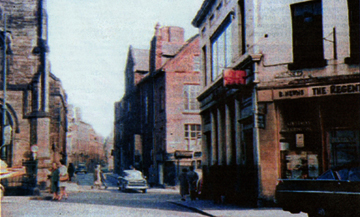 The Rising Sun in Bridge Street Row was recorded in Cowdroy's Directory in 1785, its licencee being Thomas Smith, in Pigot's Directory in 1818, licencee John Randle, in the same directory in 1828, licencee John Williams (also recorded as being there in 1822-3). In 1840 it was John Roberts, The Chester Trades Directory 1850, gives the licencee as Ann Roberts and the Post Office Directory of Cheshire 1857, Thomas Orme (Slater's has him there in 1855). The Rising Sun in Bridge Street Row was recorded in Cowdroy's Directory in 1785, its licencee being Thomas Smith, in Pigot's Directory in 1818, licencee John Randle, in the same directory in 1828, licencee John Williams (also recorded as being there in 1822-3). In 1840 it was John Roberts, The Chester Trades Directory 1850, gives the licencee as Ann Roberts and the Post Office Directory of Cheshire 1857, Thomas Orme (Slater's has him there in 1855).
Right: The junction of Pepper and Bridge Streets before the coming of the Inner Ring Road.
In July 1863, the Cheshire Observer referred to The Rising Sun, stating that it was formerly the venerable Blue Posts Inn, to which was attached a remarkable story: in 1558 Dr Henry Cole, Dean of Old St. Paul's Cathedral, was charged by Queen
Mary with a commission to the Council of Ireland, instigating the persecution
of the English Protestants. The doctor stopped one night in Chester en route
for Dublin, staying at the Blue Posts in Bridge Street, then kept by a Mrs
Mottershead. While here, he was visited by the Mayor, to whom he he related
his errand. Pointing to the leather box containing the commission, the good
doctor exclaimed "Here is what will lash the heretics of Ireland!" The Landlady,
overhearing this- and having a brother in Ireland- when the room was empty
removed the documents and replaced them with a pack of cards, the Knave of
Clubs uppermost. The deception was not discovered until the good doctor arrived
in the presence of the Lord Deputy and Privy Council at Dublin Castle. The
surprise of the whole assembly upon opening the box may be more easily imagined
than described. Doctor Cole was immediately sent back to London for a more
satisfactory authority, but before he could return, Queen Mary had breathed
her last. The ingenuity of Mrs Mottershead was rewarded by Elizabeth I (1533-1603), who came
to the throne this year, with a pension of £40 per year- a very considerable
sum at the time.
A will of 24th April 1788 mentions The Moon Tavern, licencee Thomas Fluitt, trading "on the east side of Bridge Street". Another Moon Tavern was in nearby Watergate Street, later renamed, and well remembered, as Ye Deva Hotel and now split into a shop below and Amber Lounge on the Row above.
The King's Arms, whose landlady in 1815 was Mrs Griffiths.
The Clasped Hands Inn traded in Bridge Street in 1724.
Hassall's Vaults appears in the 1871 census trading in Bridge Street East.
The Greyhound Inn was listed in the History, Gazetteer & Directory of Cheshire, 1850 when its landlord was William Bramall. Another Greyhound Inn continues to thrive in Saughall.
The Rose & Crown- was trading here in 1724 and recorded as being used as a polling station in 1809. Another Rose & Crown was trading in Brook Street in 1828.
The New Bridge Tavern (Victoria Lodge of Independent Odd Fellows), located in Bridge Street Row, appeared the Chester Trades Directory for 1840, licencee Thomas Haddock. It's likely that the New Bridge Tavern was actually where the current Oddfellows is now on Lower bridge Street because,
1) the current Oddfellows was once known as Bridge House.
2) The current Oddfellows has "Independent Order of Oddfellows" written on the front of the building.
But why is it listed as being on Bridge Street (meaning Upper Bridge Street), and why is it listed as being a row building? Bridge House was built in the 17th century and never once had a row. Just another puzzle in the complex history of Chester's pubs...
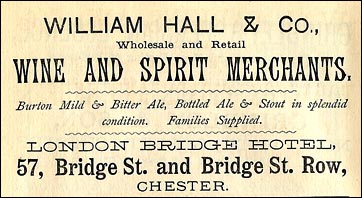 The Union Arms - also recorded in the polling station list in 1809. It appears in Cowdroy's Directory in 1789 when the licencee was Samuel Thring, and Pigot's Directory shows it trading in 1818-28, when the licencee was William Griffiths. The Union Arms - also recorded in the polling station list in 1809. It appears in Cowdroy's Directory in 1789 when the licencee was Samuel Thring, and Pigot's Directory shows it trading in 1818-28, when the licencee was William Griffiths.
The Crown & Angel (no 53): "at the end of Saynte Olas Lane eastward" ie on the left-hand corner of St. Olave's Lane. It remains a venerable-looking shop now housing a business called 'Dollectables'.
Another 'Angel'- The Angel Inn was located at the current 18-24 Lower Bridge Street.
The Three Pigeons- a 1750 edition of the Chester Courant advertised stage chaises setting out from here "every Moday to reach London in four days".
The White Swan.
Rowe Duttons-
a wine merchants and public house which was part of the Brooksbanks company (see below) with, unique in Chester, a licence with allowed them only to open six days a week (closed on Sundays) and then only until 9pm. Their extensive crypt and
cellar later housed the Chester Chronicle's printing presses and paper store. Today the site is occupied by Cafe Uno-Italiano. A special feature about the Brooksbanks business, with some fascinating photographs by Keith Rhodes and Chris Langford, is here.
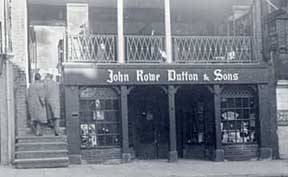 The London Bridge Hotel (nos. 49 Bridge Street and 57 Bridge Street Row: illustrated left and in our gallery). In 1853 this was called The Bridge Inn. It was listed as such in the History, Gazetteer & Directory of Cheshire, 1850 when the licencee was Thomas Haddock and in Slater's Directory 1855, J Heppel in charge. The London Bridge Hotel (nos. 49 Bridge Street and 57 Bridge Street Row: illustrated left and in our gallery). In 1853 this was called The Bridge Inn. It was listed as such in the History, Gazetteer & Directory of Cheshire, 1850 when the licencee was Thomas Haddock and in Slater's Directory 1855, J Heppel in charge.
Another Bridge Inn continues to thrive on the canalside in Vicar's Cross.
When the name changed is unknown (the Bridge Inn does not appear in the 1871 directory) but the landlord of The London Bridge Tavern from 1898 to at least 1914 was Thomas Horn, 1919-20 T Hand, late 1930s to 1942 Thomas Shrives Evans (who moved from here to the Royal George Hotel in George Street and died there in 1952). Phillipson & Golder say E Morris was here in 1934-5 however.
Situated immediately to the right of Feathers Lane, there were 2 bars, one on street level & one on the row above. Its name derived, not from the famous bridge in the capital, but from its proximity to Messrs Beckett's 'London House' and also to the bridge which ran over old Feathers Lane (which is still there today) and which led to the extensive stables at the rear of The Feathers Hotel (see next entry). This bridge, which allowed continutity to Bridge Street Row as it crossed the lane, could be divided in the middle to allow high loads of hay, etc, to pass through. It was rebuilt, along with the rest of St. Michael's Row, in
1891 by the prolific Chester architect Thomas Lockwood and was on street and row level with a steep
stairway at the rear of the building, "very handy for a quick getaway" as local historian Len Morgan recently wrote... It lost its licence around 1950, and became a branch of the Pearl Assurance Company. Today, the old pub is a coffee bar and clothes shop at one of the main entrances to the Grosvenor Precinct- or The Mall, as it is officially called now.
"Total abstinence is so excellent a thing that it cannot be carried to too great an extent. In my passion for it I even carry it so far as to totally abstain from total abstinence itself." Mark Twain.
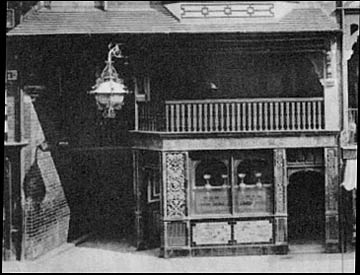 The Feathers Hotel ("and commercial inn"), 33 Bridge Street, was for at least two centuries one of Chester's foremostcoaching inns. In1829 the licencee was William Jones, The Feathers Hotel ("and commercial inn"), 33 Bridge Street, was for at least two centuries one of Chester's foremostcoaching inns. In1829 the licencee was William Jones,
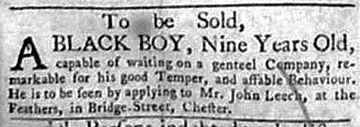 "Will Jones, of the Feathers, will welcome his friends "Will Jones, of the Feathers, will welcome his friends
And worthy Equestrians, second in grade;
At One he will lunch them, and make full amends
By the plentiful tables invitingly laid".
(from An Invitation to Chester Races 1829)
In 1850 the landlord was William Robinson, who advertised "superior accomodation for visitors and families, neat cars, gigs etc". The old Feathers was demolished in 1865 to make way for St. Michael's Arcade, whose high and elaborate pseudo-Tudor elevation now forms one of the entrances to the Grosvenor Precinct. What was once the entrance to the extensive stables situated behind the inn remains with us today, and perpetuates its name: Feathers Lane.
In 1658, the will of Thomas Heath stated, "my wife Anne Heath to have my messuage situate in Bridge-street in Chester called The Plume of Feathers, now in the possession of Edward Burrowes, innholder".
This inn was listed in Cowdroy's Directory in 1789 when the licencee was Mrs Adams, in 1822 Mercy Tomlinson (she had been licencee of the White Lion Hotel in Market Square in 1817), in 1840 Benjamin Wood, in 1857 W Robinson. In 1880, Slater's Directory gives the licencee as William Broe. The 1902 edition of Kelly's Directory lists William Williams as the landlord (still there in 1910) and in 1914 John Newns. Another Plume of Feathers was trading in Boughton in 1828.
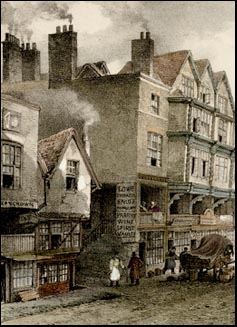 Another inn of similar name traded just down the road, as, around 1864, The Hawarden Castle Inn next door to Tudor House in Lower Bridge Street was renamed The Feathers Inn. Was the name of the earlier inn transferred here when the former was demolished in 1865? Another inn of similar name traded just down the road, as, around 1864, The Hawarden Castle Inn next door to Tudor House in Lower Bridge Street was renamed The Feathers Inn. Was the name of the earlier inn transferred here when the former was demolished in 1865?
The Grotto Hotel (no 30 Bridge Street Row West, next door but one to the corner of Commonhall Street and close to Ye Old Vaults and The Grapes Tavern- see below). In the 1980s the Grotto became for a while Sir Edward's Wine Bar until being transformed into a branch of Liberty's clothes store. The Row-level premises are still occupied by a clothes store, below which, on the street level, is a branch of Oddbins wine merchants.
The Grotto Hotel
had formerly been known as The Harp & Crown which was mentioned in a 1751 Cheshire Sheaf as being "next to Common-Hall Lane". In 1707, one Thomas Heath petitioned "to build a shop in the Row before the Harp and Crown Inn". It was listed in Cowdroy's Directory in 1789 when the licencee was Mrs Doughterty.
The 1840 illustration on the right shows The Harp & Crown on the extreme left and Barlow's in the centre, just past the entrance to Commonhall Lane. On the left, we see the same area at night, sometime during the late 1960s. Some interesting pictures (in addition to a fascinating reminiscience and a cheeky poem about the Grotto by the music hall performer Douglas Young) - and of Barlow's may be perused in our gallery.
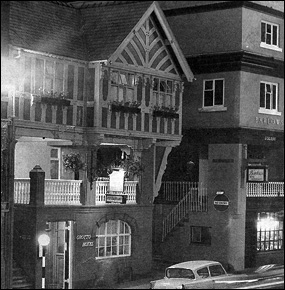 The Harp & Crown was recorded as being used as a polling station in 1809. It was one of a number of properties in Chester to be subject to the Execution Rent. Execution Rent tenants were bound to keep watch for the city on three nights in the year, namely on Christmas Eve, Christmas Day, and St. Stephen's Day (26th December) and they were bound to mount guard over and conduct felons and robbers as far as the gallows. For their services these tenants were "exempt from attendance on all inquisitions, juries and assizes, except when held before the Lord, the Prince and the Earl of Chester". In 1818-20 the licencee was Edward Lancelly, in 1822-28 Hamlet Ley (another directory spells his name Hamnet Lea), in 1840 Henry Jones, in 1850 William Edwards, in 1857 (when it was still the Harp & Crown) J Roberts, in 1880 Ebenezer W Jones, in 1902 Joseph Ingoldsby, who was still there in 1920, in 1934 W E Evans. The Harp & Crown was recorded as being used as a polling station in 1809. It was one of a number of properties in Chester to be subject to the Execution Rent. Execution Rent tenants were bound to keep watch for the city on three nights in the year, namely on Christmas Eve, Christmas Day, and St. Stephen's Day (26th December) and they were bound to mount guard over and conduct felons and robbers as far as the gallows. For their services these tenants were "exempt from attendance on all inquisitions, juries and assizes, except when held before the Lord, the Prince and the Earl of Chester". In 1818-20 the licencee was Edward Lancelly, in 1822-28 Hamlet Ley (another directory spells his name Hamnet Lea), in 1840 Henry Jones, in 1850 William Edwards, in 1857 (when it was still the Harp & Crown) J Roberts, in 1880 Ebenezer W Jones, in 1902 Joseph Ingoldsby, who was still there in 1920, in 1934 W E Evans.
The Highland Man- mentioned in a 1750 Chester Courant. In later years it was recorded as 'The Island Man'. Was the landlord a Scotsman who dropped his aitches? In 1752, Edward Williams advertised that he had moved from "The Highland Man to a well-accustomed inn, being the Sign of the Old Yacht in Watergate Street". Mr Hayes was the licencee in 1781.
The Phoenix in Bridge Street Row is listed in the 1822-3 Chester Trades Directory, its licencee Charles Blake.
The Sign of St. George.
The Globe. Listed in Pigot's 1828-1829 Directory when the licencee was Thomas Ebery. Another Globe in Castle Street is listed in the History, Gazetteer & Directory of Cheshire, 1850.
The Punch Tavern (Bridge Street Row). Also listed in the History, Gazetteer & Directory of Cheshire, 1850 when its licencee was William Chambers.
The Livre- in existence in 1805
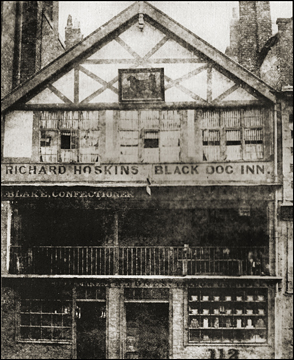 The Holywell Packet. The Holywell Packet.
The Black Dog Tavern (Bridge Street Row)- recorded in the Cheshire Sheaf as existing in 1815, lying on the north side of 'Bromfield's Entry'. In Pigot's Directory for 1818-20 the licencee was William Hodson (who was still there in 1823), in that publication for 1828/9 Robert Griffith was listed, as he was in 1840 when his house was referred to as The Black Dog Coffee House and Tavern. In the Chester Trades Directory in 1850 its licencee was Richard Hoskins, a once well-known local comedian, "a power on the Chester stage". "That favourite resort of many of the principal tradesmen.. Many
a dramatic star stayed a night at the Black Dog and afforded pleasant
recreation and harmony, no doubt, to Dick's then numerous and mirthful
circle".
Such was the effect of Mr Hoskins upon this inn that one 19th century directory lists it as Dick's Black Dog. When the early photographer Henry Fox-Talbot (1800-77), inventor of the negative-positive process, visited Chester in the 1840s, he made this image of the Black Dog, one of the earliest known photographs of the city. You can see Richard Hoskin's name above the door.
Ye Old Vaults (28 Bridge Street and 26 Bridge Street Row)- affectionately known as Barlow's, after George Barlow, who was landlord in 1898- and was still there in 1942 (44 years!) - closed for good on the
15th March 2002 when owners Scottish & Newcastle found that it (to quote the Chester Chronicle) "did not fit in with their company portfolio, which is geared towards theme pubs". Frank
Marnell, secretary of the Chester Licenced Victuallers Association (and
landlord of the Watergate Inn), commented, "the brewery has sold out on
Ye Old Vaults".
Established in 1789 and refurbished in 1900, Barlow's was
unusual in being on two levels, one bar on the street and the other on
the Row above. You could walk from the cellar up to the top floor, three floors above street level, making it one of very few complete Rows buildings in Chester.
The Vaults was yet another Chester
pub with a reputation for being haunted- over the years there
have been reports of loud groaning wails and banging noises. It is said
that these emanated from the spirit of an old-time landlord who had been
very proud of his inn and dedicated his life to maintaining its
quality. Unlike the philistine Scottish & Newcastle, sadly, who
briskly turned the listed building into a 'shopping development'- the
frontage was torn out and replaced by bland plate glass windows and the
premises has become yet another clothes shop with self-catering holiday flats above. We can only hope that
the outraged landlord's spirit does his worst. (See the ghosts entry in our site index for links to many other reputedly-haunted Chester pubs.)
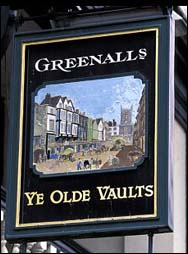 Talking of spirits, Mr Barlow used to blend and bottle his own whiskey at the back of the pub he also used to bottle beer and soft drinks. Talking of spirits, Mr Barlow used to blend and bottle his own whiskey at the back of the pub he also used to bottle beer and soft drinks.
James Jones was shown in Louise Rayner paintings to be licencee of The Old Vaults and an 1853 map also shows him there. Also there was a James Jones in 1855 who was licencee of The Leopard Inn on Bridge Street. There was only one James Jones listed for Bridge Street around those years, so our guess is that he ran The Old Vaults, changed its name to The Leopard Tavern (what it was before is currently unknown), and then took the name with him to an inn in Foregate Street during 1857. He is last listed there in 1864, so this ties in with him passing away in 1866. Mr Jones was mentioned as licencee of the Leopard Inn in a police report in the Cheshire Observer, 25th August 1855.
Reader Annette
Edwards wrote to tell us that one of her family, Arthur Wilcoxon was the publican at The Olde Vaults from 1871 to at least 1875. By 1877 he had moved to 9 Paradise Row, a long-vanished street that once faced onto the Roodee. Nev Hewitt had the place in 1976-79. Interestingly, the name 'Hewitt' appears on the building's facade in another painting of Bridge Street by Louise Raynor.
We're informed that Barlow's upstairs bar or lounge was know as “the passion parlour" in World War II as it was a favourite, intimate rendezvous for servicemen and their lady friends.
• The landlord of the still-thriving 300 year old Coach & Horses (now renamed The Coach House) in Town Hall Square between 1881 and 1901 was one James Barlow. Were he and William related?
The Grapes Tavern was located in Bridge Street Row in 1840, licencee John Padmore. The Chester Chronicle, 24th March 1843 mentioned the Grapes and said it was situated opposite Grosvenor Terrace on upper Bridge Steet. Was Grosvenor Terrace where St. Michael's Arcade is? This would place it in close proximity to the Old Vaults (Barlow's) and the Harp & Crown.
Advertisment in the Chester Courant,
December 4th 1750: "To be let, proper for an inn or an ale-house, with
stables or without, a good accustomed house, with very good cellars,
formerly The Horse & Baggs, lately The White Horse, in the Bridge-street, Chester, at the corner of White-Fryer's Lane".
"In my opinion, most of the great men of the past were only there for the beer." A. J. P. Taylor, historian
 Lower Bridge Street: The Lamb or Ye Olde Lamb (nos. 2 and 4 Lower Bridge Street). Popularly known as The Dive Bar as it was situated in the basement of Brooksbanks Wine Merchants and separated by a narrow lane, Little Cuppin Street, from the ancient, but still-extant Falcon Inn. Its landlord in 1910 was George F Sharp, in 1914 W C Thornhill. Lower Bridge Street: The Lamb or Ye Olde Lamb (nos. 2 and 4 Lower Bridge Street). Popularly known as The Dive Bar as it was situated in the basement of Brooksbanks Wine Merchants and separated by a narrow lane, Little Cuppin Street, from the ancient, but still-extant Falcon Inn. Its landlord in 1910 was George F Sharp, in 1914 W C Thornhill.
This interesting photograph, remarkable even to those who thought they
knew this area well, shows its final days in 1961, just before it was
demolished to make way for the widening of Grosvenor Street as part of
the Inner Ring Road scheme and its site is now lost beneath the busy road junction we know
today. (See another rather fuzzy photograph of it and, possibly, its
landlord, here). The photographer would appear to have been standing in the ruins of the recently-demolished Red Lion (see below).
Its
predecessor, on the same site, was a timber building whose upper storey
protruded so far over the street and whose creaking beams sagged so
fantastically that it quickly achieved a reputation as being Chester's
most picturesque building and was portrayed by many visiting artists.
Originally constructed as the home of historian and heraldic artist
Randle Holme III in 1655, it was later converted into shops, a market
and finally into an inn- The Lamb Inn, which gave its
name to a long vanished Row, Lamb Row. So unfeasable was the structure,
however, that the whole thing inevitably collapsed into the street in
1821. The Chester Chronicle reported at the time, "this
ancient pile, like all the works of man, underwent a severe shock from
the hands of time... the projecting portion of the south end suddenly
gave way and tumbled into the street with a loud crash. An immense
volume of dust rose from the ruins, and it was some time before
bystanders could ascertain what damage was done and whether any injury
had been sustained". Miraculously, nobody was hurt, but an elderly
inhabitant of the house, Sarah Adams, had a nasty shock when the wall
of the room she was sitting in collapsed within six inches of her
chair.
• A special feature about the Brooksbanks business, with some fascinating photographs by Keith Rhodes and Chris Langford, is now here.
Also connected with a vanished Row was The Old Coach Inn which was the third house up from the corner of Duke Street in Old Coach Row- also known as Rotten Row. It is seen in one of Batenham's views of 1817 which records its sign, "W Carlile, Ale and Porter". William Carlisle is indeed recorded as the licencee in Pigot's Directory for the years 1818-23. The site is now occupied by a large, ugly and extremely inappropriately-situated car showroom. Or should we say 'ex-car showroom' as the place has sat empty and unwanted for a considerable period of time. Surely it's high time to be rid of this boil upon the face of a lovely street?
The Old Coach was recorded as being used as a polling station in 1809. Some paintings of Old Coach Row by the noted watercolourist Louise Rayner and a contemporary photograph of the area by the author may be seen here.
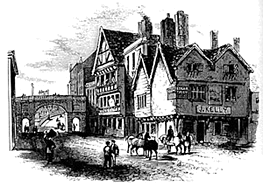 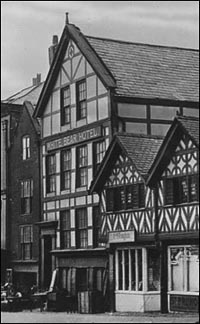 The Old Edgar, on the corner of Shipgate Street (right) dates from around 1500. After years of dereliction it was restored and now serves as a private residence. In 1828, when it was called The Edgar Tavern, in 1871 The King Edgar. In 1822 the licencee was Richard Moulton, in 1840 John Moulton, in 1850 George Owens, in the early 20th century T Rimmer. During his reign, a 1905 postcard advertised 'The Edgar Tavern', as it was then still called, as offering "refreshment rooms and accomodation for cyclists". A selection of interesting photographs of the Old Edgar, and a painting of it by Louise Rayner, may be seen in our gallery. The Old Edgar, on the corner of Shipgate Street (right) dates from around 1500. After years of dereliction it was restored and now serves as a private residence. In 1828, when it was called The Edgar Tavern, in 1871 The King Edgar. In 1822 the licencee was Richard Moulton, in 1840 John Moulton, in 1850 George Owens, in the early 20th century T Rimmer. During his reign, a 1905 postcard advertised 'The Edgar Tavern', as it was then still called, as offering "refreshment rooms and accomodation for cyclists". A selection of interesting photographs of the Old Edgar, and a painting of it by Louise Rayner, may be seen in our gallery.
The Lower White Bear (illustrated right) was in Lower Bridge Street, next door but one to the still-thriving Falcon Inn. It was listed in Cowdroy's Directory in 1789 when the licencee was Mrs Evans. Pigot's Directory shows the Lower White Bear trading in 1828 at 12 Lower Bridge Street, its landlord being Thomas Jones. It appears in Slater's Directory 1855, under the name 'Upper White Bear/White Bear' proprietor Mrs Elizabeth Onslow and The Post Office Directory of Cheshire 1856 (called simply The White Bear), Mrs Onslow still in charge. Edwin Swindley was the gaffer in 1871, David Thomas in 1880 and Kelly's Directory 1902 lists Robert Smith as the licencee. Sometime after this Edward Eccles had the place until William Donworth took over in October 1914. An auctioneer's inventory we have seen of the inn's contents, dating from October 1918, perhaps point to Mr Donworth's demise- but the name W Donworth again appears in the trade directory for 1919-20..
The Upper White Bear (Bridge Street). Advertisement in Adams’s Weekly Courant, 26 March 1782:
"ROBERT JONES, Respectfully informs his Friends and the Public, THAT he is removed from the White-Hart in Foregate-street to the UPPER WHITE BEAR Inn, Bridge-street, and has fitted up the same with every necessary Convenience, suitable for the Reception of Travellers. He has also laid in a good Stock of genuine Wines, Liquors, &c. and his Customers may depend, that every Endeavour will be used to render their Accommodations perfectly agreeable, and a scrupulous Regard paid to their Commands, by the Public’s obedient Servant, ROBERT JONES".
The Upper White Bear is listed in Cowdroy's Directory in 1782, its licencee being Robert Jones. Pigot's Directory shows the inn trading in 1828, its landlord being Richard Snelson, who had been there since at least 1822.
It gets confusing I know and have no idea which of the above is referred to in an 1822 listing for The Old White Bear in Bridge Street, licencee J Jones. Mr J Hopson had an inn simply called The Bear in 1781...
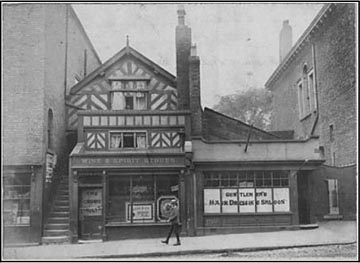 The Crown Vaults (illustrated left, 1930s? and below, as it appeared in 1969). No 22, the west side of Lower Bridge Street.. Listed in the 1890 Kelly's Directory of Cheshire and also in the 1910 edition when the licencee was William Deacle. There was another Crown Vaults trading on the corner of Canalside and Seller Street. The Crown Vaults (illustrated left, 1930s? and below, as it appeared in 1969). No 22, the west side of Lower Bridge Street.. Listed in the 1890 Kelly's Directory of Cheshire and also in the 1910 edition when the licencee was William Deacle. There was another Crown Vaults trading on the corner of Canalside and Seller Street.
The splendidly-named Roman Bath Beer and Eating House traded in Bridge Street in 1840, proprietor William Stubbs.
The Llangollen Tavern. The Chester Chronicle, 16th May 1863 mentioned this inn trading on Lower Bridge Street, licencee Elizabeth Hayes.
The 1871 census lists The Brushmaker's Arms trading in Lower Bridge Street.
Also mentioned in the 1871 census was Rogers Public House.
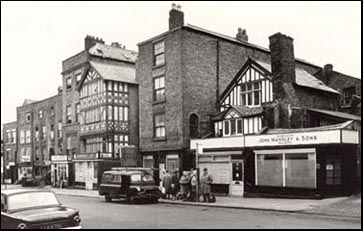 The Talbot, originally the lower floor of the grand private mansion Park House which was built around 1717 for Elizabeth Booth. Extended in 1818, it became The Albion Hotel. It was this in 1822 when the licencee was William Tomlinson, in 1850 Thomas Whaley, in 1855-7 J Chambers and in 1871 Thomas Sparks- and then The Talbot Hotel.
When it ceased to be a private home, the two acres of parkland behind
the house became Chester's first public pleasure gardens. When these
closed in 1865, the land was covered with terraced houses (most of
which remain with us as charming private homes today) and the old hotel
commemorated by naming one of the new streets, Albion Street. The large
central hall had served as a ballroom, an assembly room and an antiques emporium and later became Claverton's and the upper floors utilised as offices. The Talbot, originally the lower floor of the grand private mansion Park House which was built around 1717 for Elizabeth Booth. Extended in 1818, it became The Albion Hotel. It was this in 1822 when the licencee was William Tomlinson, in 1850 Thomas Whaley, in 1855-7 J Chambers and in 1871 Thomas Sparks- and then The Talbot Hotel.
When it ceased to be a private home, the two acres of parkland behind
the house became Chester's first public pleasure gardens. When these
closed in 1865, the land was covered with terraced houses (most of
which remain with us as charming private homes today) and the old hotel
commemorated by naming one of the new streets, Albion Street. The large
central hall had served as a ballroom, an assembly room and an antiques emporium and later became Claverton's and the upper floors utilised as offices.
With the demise of Claverton's the place became, briefly, The Lobby. When this in turn closed, there was some hope of it reverting back to being another Lee's establishment (as when it was Claverton's) but it seemed Lee's had had their fill with Chester after their financially disastrous adventure with The Mansion House in Love Street (see below)
and the premises became, depressingly, yet another of the area's many estate
agents.
Reader Keith Ellis told us "as far as I can recall the Talbot
was a McEwan's house selling Tartan Bitter. It had a car park at the
side through which you could get to the Albion".
The Chester artist Jill Pears told us "The Talbot was a single bar all done out in metallic paint in stucco style and wall lights. I was in the International Voluntary Service at the time and we'd go down there after our meetings. It later became Claverton's and enlarged, with cream walls and oak beams and arches, the bar being at the back. It was a lovely cosy place to go, we loved it there."
There were once other Talbots in Chester: in Newgate Street and, until very recently, in Walter Street, Newtown.
Kelly's Directory for 1902 lists The Birmingham Arms at 15 Lower Bridge Street when Reginald Johnson was the licencee. He was still there in 1910. Earlier, in 1855 it was Samuel Stephens, in 1871 Elizabeth Hodgkinson and in 1880 Joseph Beckett.
The Liver. Listed in Pigot's 1818-20 directory and also in 1822-3 when the licencee was William Foulkes, in 1828-1829 when Thomas Phillips was in charge and in The Post Office Directory of Cheshire in 1857.
The Nelson appears in the Post Office Directory of Cheshire in 1857 when the licencee was T Parry.
The Phoenix (Bridge Street Row). Listed in Pigot's Directory 1818-20 when the licencee was John Jackson and also in 1828-1829, licencee Charles Blake. He was still there in 1831 as he was recorded as licencee an article in the Chester Courant, 21st June of that year.
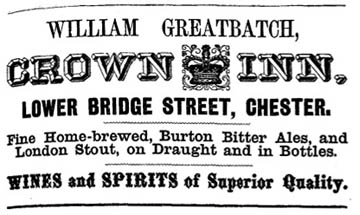 The Millstone. Listed in Pigot's 1828-1829 Directory. A Millstone also appears under Lower Bridge Street in this directory so may have been the same pub situated at the junction of the two. However, the licencees names differ; Thomas Ball at the Lower Bridge Street Millstone and Charles Hilditch in the Shipgate Street one. The Millstone. Listed in Pigot's 1828-1829 Directory. A Millstone also appears under Lower Bridge Street in this directory so may have been the same pub situated at the junction of the two. However, the licencees names differ; Thomas Ball at the Lower Bridge Street Millstone and Charles Hilditch in the Shipgate Street one.
The Victoria Tavern. In 1840 George Ball was listed in the trades directory as "Victoria Tavern and Painter". Listed as The Victoria in the History, Gazetteer & Directory of Cheshire, 1850.
The Oxford Blue. Also mentioned in the History, Gazetteer & Directory of Cheshire, 1850 when its licencee was Thomas Smith. Slater's records him as still being there in 1855.
The Swan With Two Necks. Another inn with the same curious name is recorded as trading in Princess Street in Cowdroy's Directory, 1782.
In the United Kingdom, swans have traditionally been the property of the reigning Monarch. However, in the 16th century, Queen Elizabeth I granted the right to ownership of some swans to the Worshipful Company of Vintners. In order to be able to tell which Swan belonged to whom, it was decided that Vintners' swans should have their beaks marked with two notches, or nicks. In those days, 'neck' was another form of 'nick' and so the Vintners spotted that a 'Swan With Two Necks' could afford them a rather clever pun, and a striking pub sign.
The Red Lion Hotel (no 7, corner of Pepper Street, across the road from St. Michael's Church: illustrated below and extensively in our gallery). In
November 1771, one John Manwaring, retired butler, let it be known that
he had taken "the old and well-accustomed inn, the Red Lion, late of Widow Penstone's". In its time, the Red Lion was full of company when elections were on, being a 'Grosvenor' house.
At one time, it was one of the many pubs owned by the Chester Northgate Brewery.
A contributor to a 1927 edition of the Cheshire Sheaf wrote of the Red Lion, "although built in the middle of the 17th century, it bears no external sign of antiquity in consequence of restorations and structural alterations. In the interior, however, some idea of the age of the building may be gathered from the oak beams, floors and staircases, particularly those of the upper stories, which are in a fair state of preservation. On the first floor, at the front, there is a room containing an ornamental plaster ceiling... framed by a beading of plaster at the four corners of which, projecting towards the centre, are fleurs-de-lis on long stems. The centre of each panel is occupied by designs in relief but many coats of whitewash have all but obliterated them..."
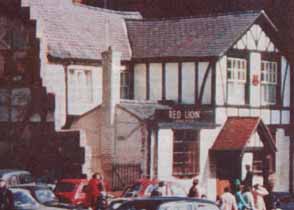 The Red Lion was listed in Cowdroy's Directory in 1789 when the licencee was William Hancock. In 1822 the licencee was Robert Roberts, in 1840 Robert Hynd, in 1850-55 Samuel Tilson, in 1857, the interestingly-named David Thomas Millions, in 1871 John Alcock, in 1880 Elizabeth Norris, in 1902 John Lloyd Jones, in 1910 Robert Johnson, in 1914-1934 Thomas Miley, in 1936-42 Ernest G Bennion. The Red Lion was listed in Cowdroy's Directory in 1789 when the licencee was William Hancock. In 1822 the licencee was Robert Roberts, in 1840 Robert Hynd, in 1850-55 Samuel Tilson, in 1857, the interestingly-named David Thomas Millions, in 1871 John Alcock, in 1880 Elizabeth Norris, in 1902 John Lloyd Jones, in 1910 Robert Johnson, in 1914-1934 Thomas Miley, in 1936-42 Ernest G Bennion.
First established in 1642, for over 300 years, the inn occupied a set-back site at the top of Lower Bridge Street
until the alterations which turned Pepper Street into Pepper Row and
the Inner Ring Road. Since then, this prominent site has been occupied
by the large and hideous office block / hairdressers premises, Windsor House.
Readers Roger and Gill Brooks- Gill is the great-grandaughter of licencee Thomas Miley- have kindly loaned us some unique photographs of the Red Lion, its landlord and his family around the start of WW1. These, and much more information, can be found on the Red Lion's own page in our old pubs gallery.
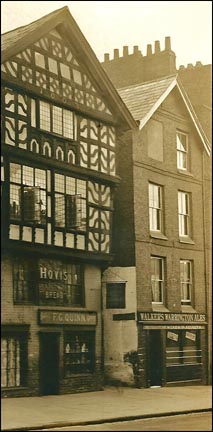 The Black Horse Inn was adjacent to Rock's Court and in existence in 1810 when the licencee was James Walker. In 1818-22 it was E Walker, in 1828 Richard Smith, in 1840 William Smith (another directory says Thomas Jones), in 1846 George Davies, and in 1850 Mary Ann Hopkin. The Black Horse Inn was adjacent to Rock's Court and in existence in 1810 when the licencee was James Walker. In 1818-22 it was E Walker, in 1828 Richard Smith, in 1840 William Smith (another directory says Thomas Jones), in 1846 George Davies, and in 1850 Mary Ann Hopkin.
In 1826 and 1827 meetings of the Smiths and Bricklayers Companies were held there. In that year is was described as "third south of The Red Lion (see above) and fifth north of The Hawarden Castle Inn (also below), about eighty yards south of St. Michael's Church." The inn was formerly the private house of John Rock, a member of the legal profession, who lived there from 1664 (when he enlarged it from two hearths to four) until his death in 1689.
Sometime between 1850 and 1855 the Black Horse changed it's name to The Birmingham Arms.
Kelly's Directory for 1902 lists The Birmingham Arms at 15 Lower Bridge Street when Reginald Johnson was the licencee. He was still there in 1910. Earlier, in 1855 it was Samuel Stephens, in 1871 Elizabeth Hodgkinson and in 1880 Joseph Beckett. On 3rd July 1858, the Chester Chronicle mentioned that was in the possession of Seller's Brewery.
The building that once housed the old inn hosted a ladies' clothes shop, Phyllis of Chester, in the 1960s and is now occupied by an estate agent.
Talking of the Hawarden Castle Inn (a Walker's house, illustrated left), in October 2008, Norma Vachet (nee Stanley) from far-away Vancouver, Canada wrote to tell us that "my Stanley family lived in Chester at Lower Bridge Street in 1858. My Great Great Grandfather William Stanley was a 'licensed victualler' and his wife Mary (Blundell) Stanley is listed as a Publican's wife according to the 1861 census. One of their sons is listed as being born at The Hawarden Castle Inn, Lower Bridge Street, Chester". A few years earlier, the Post Office Directory for the year 1857 lists one William Stanley as the licencee.
In Lower Bridge Street, next to the splendid, and much-photographed, early 17th century Tudor House, is a narrow passageway by the name of Hawarden Castle Entry which formerly led to an area of mean and squalid court dwellings. It features in one of Louise Rayner's famous watercolours and can be seen here. Did the inn serve the poor community in the vicinity of this narrow street? In 1828 the licencee was William Ellis, in 1850 John Hughes and, as Norma tells us, in 1857-61William Stanley.
It is just possible to make out the name 'W Williams' over the inn's door in the photo, whose date is unknown by was taken and published as a postcard by the famous Chester firm of Will R Rose.
In the 1870s a linking bridge over Hawarden Castle Entry was built from the Hawarden Castle Inn, that used the upper parts of Tudor House as an annex for paying guests (the lower part in the photograph is occupied by 'F C Quinn, Baker & Grocer').
The sign hanging from the front of Tudor House announces, "Cestrian Lodging House. Beds 6d & 8d. R Griffiths".
The postcard, incidentally, is entitled 'The Oldest House in Chester'. Just above the upper window of Tudor House may be seen the date '1006' painted onto a beam.
This has long since disappeared, but a cartouche bearing the inscription 'Built in the reign of Henry VII 1506' is now prominently displayed on the building's facade. Both are incorrect, the house probably having been erected a century later, around 1606 (perhaps the top of one of the sixes in the earlier date got accidentally painted over and the '1006' then became accepted?) The building still stands, today utilised as an estate agent's premises, illustrated on the inn's own page in our gallery here.
Somewhere between 1860 and 1864, the Hawarden Castle Inn was renamed The Feathers Inn.
Interestingly, the more famous Feathers Hotel, just up the road in Bridge Street was demolished in 1865. Was its name transferred here? On 17 March 1866, the Chester Chronicle advertised the Hawarden Castle/Feathers Inn as having "a spirit vault, bar parlour, vaulted cellars, kitchen, sitting room, eight bedrooms, back yard and a large stable".
The Britannia Inn was trading in Bridge Street in 1822-3 when its licencee was William Connah. This inn was located on the ground floor of the above-mentioned Tudor House. The premises are now inhabited by the Tudor House Deli.
"A woman drove me to drink and I didn't even have the decency to thank her." W.C. Fields |
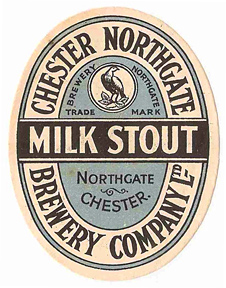

 • Coming soon (we hope):
• Coming soon (we hope): 


 • On the left is a rather fuzzy old photograph of the 17th century 'Dutch Houses' in Bridge Street. The sign above the Row level says 'Hooleys Marstons' and therefore, I assume, a pub. I have no record of it and wondered if anyone else had. I have found licencees by the name of Hooley (Frederick) in Northgate Street and Handbridge (Elizabeth) but, so far, nobody trading here. Your suggestions are welcome!
• On the left is a rather fuzzy old photograph of the 17th century 'Dutch Houses' in Bridge Street. The sign above the Row level says 'Hooleys Marstons' and therefore, I assume, a pub. I have no record of it and wondered if anyone else had. I have found licencees by the name of Hooley (Frederick) in Northgate Street and Handbridge (Elizabeth) but, so far, nobody trading here. Your suggestions are welcome! • It's a tad dated now but we still recommend a visit to
• It's a tad dated now but we still recommend a visit to  he
production and consumption of strong drink has long been enjoyed in Chester. We know nothing concerning the drinking places of the Roman occupants of the
fortress of Deva Victrix, but much, perhaps, may be inferred from the Roman city of
he
production and consumption of strong drink has long been enjoyed in Chester. We know nothing concerning the drinking places of the Roman occupants of the
fortress of Deva Victrix, but much, perhaps, may be inferred from the Roman city of  In 1552, during the reign of Edward VI, an Act was passed that restricted the number of taverns in London to 40 and in Chester just two. The guild system dominated and regulated the trade of old Chester. The Guild Mercatorial was divided into companies of two or three trades each and only members of these companies were permitted to trade freely. All others were deemed 'strangers'. 'The Company of Innkeepers, Victuallers and Cooks' was considered ancient when it was incorporated by Royal Charter under the Mayor of Chester in 1583. The restrictions of thirty years earlier upon tavern numbers had obviously been relaxed for 34 brethren were recorded at this time. The company enjoyed many rights and privileges including a monopoly on the sale of liquors within the boundaries of the city.
In 1552, during the reign of Edward VI, an Act was passed that restricted the number of taverns in London to 40 and in Chester just two. The guild system dominated and regulated the trade of old Chester. The Guild Mercatorial was divided into companies of two or three trades each and only members of these companies were permitted to trade freely. All others were deemed 'strangers'. 'The Company of Innkeepers, Victuallers and Cooks' was considered ancient when it was incorporated by Royal Charter under the Mayor of Chester in 1583. The restrictions of thirty years earlier upon tavern numbers had obviously been relaxed for 34 brethren were recorded at this time. The company enjoyed many rights and privileges including a monopoly on the sale of liquors within the boundaries of the city. The Chester Directory for the year 1792 recorded
around 140 inns in the small market town. By 1858, numbers had increased considerably and Thomas Hughes recorded 36 trading
in
The Chester Directory for the year 1792 recorded
around 140 inns in the small market town. By 1858, numbers had increased considerably and Thomas Hughes recorded 36 trading
in 
 The George Hotel (no. 5, now the corner of the busy Hoole Way stretch of the
The George Hotel (no. 5, now the corner of the busy Hoole Way stretch of the 

 'The Grapes' is a very common pub name in Liverpool but we've only traced two trading in Chester so far- one here in Boughton and one in Bridge Street (see
'The Grapes' is a very common pub name in Liverpool but we've only traced two trading in Chester so far- one here in Boughton and one in Bridge Street (see  The Black Lion Inn-
no. 166 Boughton, corner of The Mount- illustrated right. Now a landscaped, but otherwise empty, space. It was supposedly
demolished for road widening but also, allegedly, because of the
'undesirable' nature of some of the regulars, or so we were informed-
by one of them!
The Black Lion Inn-
no. 166 Boughton, corner of The Mount- illustrated right. Now a landscaped, but otherwise empty, space. It was supposedly
demolished for road widening but also, allegedly, because of the
'undesirable' nature of some of the regulars, or so we were informed-
by one of them!  Pigot's Directory in 1818-20 and 1828, The Chester Trades Directory in 1850, Slater's Directory 1855, The Post Office Directory 1857 and Slater's 1880 all list an inn called The Mount Pleasant Tavern trading in Boughton, its licencee in 1818-23 being M Ramsey, in 1828 William Mayler, in 1840 Joseph Lloyd, in 1850-57 Mrs Catherine Lloyd, in 1871 James Law and in 1880 Edward Lewis.
Pigot's Directory in 1818-20 and 1828, The Chester Trades Directory in 1850, Slater's Directory 1855, The Post Office Directory 1857 and Slater's 1880 all list an inn called The Mount Pleasant Tavern trading in Boughton, its licencee in 1818-23 being M Ramsey, in 1828 William Mayler, in 1840 Joseph Lloyd, in 1850-57 Mrs Catherine Lloyd, in 1871 James Law and in 1880 Edward Lewis. "Charles Cordery was the owner of the pub in Boughton called The Cheshire Sheaf. Initially it was a house and shop, where Charles was a baker and supplier of ‘provisions'. It also became a beerhouse, licensed to sell beer and wine only. Each year Charles applied for a license to sell spirits also, but each year for 18 years he was refused! After he died in 1881 his son, also called Charles Cordery, took over the pub and also applied to sell spirits and he too was refused, despite extending and making changes to the pub interior.
"Charles Cordery was the owner of the pub in Boughton called The Cheshire Sheaf. Initially it was a house and shop, where Charles was a baker and supplier of ‘provisions'. It also became a beerhouse, licensed to sell beer and wine only. Each year Charles applied for a license to sell spirits also, but each year for 18 years he was refused! After he died in 1881 his son, also called Charles Cordery, took over the pub and also applied to sell spirits and he too was refused, despite extending and making changes to the pub interior.  It's interesting to note that, according to the Chester Observer in 1869-71, there is a Michael Collins residing in Steven Street in Boughton who owned a pub called the Erin go Braugh. The area around Steven Street was a very densely populated and poverty-stricken Irish district during that time, so it's hardly surprising that the pub's name was roughly translated as '
It's interesting to note that, according to the Chester Observer in 1869-71, there is a Michael Collins residing in Steven Street in Boughton who owned a pub called the Erin go Braugh. The area around Steven Street was a very densely populated and poverty-stricken Irish district during that time, so it's hardly surprising that the pub's name was roughly translated as ' The Chester Trades Directory for the year 1850 mentions a pub in Boughton with the cheerful name of The Jolly Gardener Tavern at 33 Christleton Road, landlord Joseph Horrocks, who had been there in 1840. It was still called this in 1855 when Charles Chesworth was in charge. He was still there two years later in 1857 but the inn's name had changed to The Gardener's Arms. Earlier, in August 1828, the Chester Chronicle mentioned an inn "opposite Sandy-lane, Boughton" called The King's Head- exactly in the location where The Jolly Gardener / Gardener's Arms would later be. So we can safely assume this was the same inn under three different names.
The Chester Trades Directory for the year 1850 mentions a pub in Boughton with the cheerful name of The Jolly Gardener Tavern at 33 Christleton Road, landlord Joseph Horrocks, who had been there in 1840. It was still called this in 1855 when Charles Chesworth was in charge. He was still there two years later in 1857 but the inn's name had changed to The Gardener's Arms. Earlier, in August 1828, the Chester Chronicle mentioned an inn "opposite Sandy-lane, Boughton" called The King's Head- exactly in the location where The Jolly Gardener / Gardener's Arms would later be. So we can safely assume this was the same inn under three different names.
 The Union Arms - also recorded in the polling station list in 1809. It appears in Cowdroy's Directory in 1789 when the licencee was Samuel Thring, and Pigot's Directory shows it trading in 1818-28, when the licencee was William Griffiths.
The Union Arms - also recorded in the polling station list in 1809. It appears in Cowdroy's Directory in 1789 when the licencee was Samuel Thring, and Pigot's Directory shows it trading in 1818-28, when the licencee was William Griffiths.

 "Will Jones, of the Feathers, will welcome his friends
"Will Jones, of the Feathers, will welcome his friends Another inn of similar name traded just down the road, as, around 1864,
Another inn of similar name traded just down the road, as, around 1864,  The Harp & Crown was recorded as being used as a polling station in 1809. It was one of a number of properties in Chester to be subject to the Execution Rent. Execution Rent tenants were bound to keep watch for the city on three nights in the year, namely on Christmas Eve, Christmas Day, and St. Stephen's Day (26th December) and they were bound to mount guard over and conduct felons and robbers as far as the gallows. For their services these tenants were "exempt from attendance on all inquisitions, juries and assizes, except when held before the Lord, the Prince and the Earl of Chester". In 1818-20 the licencee was Edward Lancelly, in 1822-28 Hamlet Ley (another directory spells his name Hamnet Lea), in 1840 Henry Jones, in 1850 William Edwards, in 1857 (when it was still the Harp & Crown) J Roberts, in 1880 Ebenezer W Jones, in 1902 Joseph Ingoldsby, who was still there in 1920, in 1934 W E Evans.
The Harp & Crown was recorded as being used as a polling station in 1809. It was one of a number of properties in Chester to be subject to the Execution Rent. Execution Rent tenants were bound to keep watch for the city on three nights in the year, namely on Christmas Eve, Christmas Day, and St. Stephen's Day (26th December) and they were bound to mount guard over and conduct felons and robbers as far as the gallows. For their services these tenants were "exempt from attendance on all inquisitions, juries and assizes, except when held before the Lord, the Prince and the Earl of Chester". In 1818-20 the licencee was Edward Lancelly, in 1822-28 Hamlet Ley (another directory spells his name Hamnet Lea), in 1840 Henry Jones, in 1850 William Edwards, in 1857 (when it was still the Harp & Crown) J Roberts, in 1880 Ebenezer W Jones, in 1902 Joseph Ingoldsby, who was still there in 1920, in 1934 W E Evans. The Holywell Packet.
The Holywell Packet. Talking of spirits, Mr Barlow used to blend and bottle his own whiskey at the back of the pub he also used to bottle beer and soft drinks.
Talking of spirits, Mr Barlow used to blend and bottle his own whiskey at the back of the pub he also used to bottle beer and soft drinks.  Lower Bridge Street:
Lower Bridge Street:
 The Old Edgar, on the corner of Shipgate Street (right) dates from around 1500. After years of dereliction it was restored and now serves as a private residence.
The Old Edgar, on the corner of Shipgate Street (right) dates from around 1500. After years of dereliction it was restored and now serves as a private residence. 
 The Talbot, originally the lower floor of the grand private mansion Park House which was built around 1717 for Elizabeth Booth. Extended in 1818, it became The Albion Hotel. It was this in 1822 when the licencee was William Tomlinson, in 1850 Thomas Whaley, in 1855-7 J Chambers and in 1871 Thomas Sparks- and then The Talbot Hotel.
When it ceased to be a private home, the two acres of parkland behind
the house became Chester's first public pleasure gardens. When these
closed in 1865, the land was covered with terraced houses (most of
which remain with us as charming private homes today) and the old hotel
commemorated by naming one of the new streets, Albion Street. The large
central hall had served as a ballroom, an assembly room and an antiques emporium and later became Claverton's and the upper floors utilised as offices.
The Talbot, originally the lower floor of the grand private mansion Park House which was built around 1717 for Elizabeth Booth. Extended in 1818, it became The Albion Hotel. It was this in 1822 when the licencee was William Tomlinson, in 1850 Thomas Whaley, in 1855-7 J Chambers and in 1871 Thomas Sparks- and then The Talbot Hotel.
When it ceased to be a private home, the two acres of parkland behind
the house became Chester's first public pleasure gardens. When these
closed in 1865, the land was covered with terraced houses (most of
which remain with us as charming private homes today) and the old hotel
commemorated by naming one of the new streets, Albion Street. The large
central hall had served as a ballroom, an assembly room and an antiques emporium and later became Claverton's and the upper floors utilised as offices. The Millstone.
The Millstone.  The Red Lion was listed in Cowdroy's Directory in 1789 when the licencee was William Hancock. In 1822 the licencee was Robert Roberts, in 1840 Robert Hynd, in 1850-55 Samuel Tilson, in 1857, the interestingly-named David Thomas Millions, in 1871 John Alcock, in 1880 Elizabeth Norris, in 1902 John Lloyd Jones, in 1910 Robert Johnson, in 1914-1934 Thomas Miley, in 1936-42 Ernest G Bennion.
The Red Lion was listed in Cowdroy's Directory in 1789 when the licencee was William Hancock. In 1822 the licencee was Robert Roberts, in 1840 Robert Hynd, in 1850-55 Samuel Tilson, in 1857, the interestingly-named David Thomas Millions, in 1871 John Alcock, in 1880 Elizabeth Norris, in 1902 John Lloyd Jones, in 1910 Robert Johnson, in 1914-1934 Thomas Miley, in 1936-42 Ernest G Bennion. 
